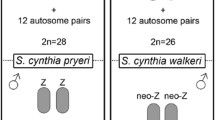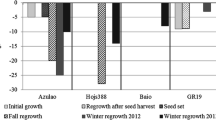Summary
A rare case of interspecific hybridization between the Indian oak feeding silkworm Antheraea roylei (n=31) and Chinese oak feeding silkworm A. pernyi (n=49) yielding fertile and vigorous offspring is reported. The F1 and the backcross (A. roylei X A. pernyi X A. pernyi male individuals of the above cross and the F23 and F32 male offspring derived from an earlier cross between another race of A. roylei (n=30) and A. pernyi (n=49) were cytogenetically analysed in order to study their chromosome dynamics. The F1 hybrids showed 18 trivalents and 13 bivalents in the first meiotic prophase and metaphase. The backcross individuals possessed either 9 trivalents and 31 bivalents or 49 bivalents, in Metaphase I cells. The F23 and F32 individuals were karyotypically alike and exhibited 49 bivalents. The following conclusions were drawn from the above observations: (a) in spite of allopatry and karyotypic divergence in number, a high degree of homology exists between the chromosomal complements of the two species; (b) A. pernyi possibly evolved from A. roylei, during the course of which 18 chromosomes of the latter underwent fission to give rise to the 36 chromosomes of the former. This is demonstrated by trivalent formation and pairing affinities in F1 hybrids; (c) selection has favoured the elimination of large A. roylei chromosomes which participated in trivalent formation in successive generations of inbred hybrids to establish a stable Karyotype like that of A. pernyi.
Similar content being viewed by others
References
Carothers EE (1941) Interspecific hybridization in the Acrididae (Trimerotropis citrina X T. maritima). Genetics 26:144
Federly H (1939) Geni e chromosomi. Sci Genet 1:186–205
Foot K, Strobell EC (1914) The chromosome of Euschistus variolarius, Euschistus servus and the hybrids of the F1 and F2 generations. Arch Zellforsch 12:485–512
Imai HT (1974) Chromosomes in the Myrmicine ant Leptothorax spinosior. Chromosoma 45:431–444
Jolly MS (1980) Distribution and differentiation in Antheraea species. Proc Int Congr Entomol Jpn 1:1–20
Jolly MS, Narasimhanna MN, Sinha SS, Sen SK (1969) Interspecific hybridization in Antheraea. Indian J Hered 1:45–48
Jolly MS, Sen SK, Prasad GK, Sengupta AK (1979) Some cytological observation on interspecific hybrid of Antheraea pernyi and Antheraea roylei. Cytologia 44:259–263
Kawaguchi E (1928) Zytologische Untersuchungen am Seidenspinner und seinen Verwandten. 1. Gametogenese von Bombyx mori L. und Bombyx mandarina M. und ihrer Bastarole. Z Zellforsch 7:519–552
Veshima N (1963) Chromosome behaviour of the Cimex pilosellus complex (Cimicidae: Hemiptera). Chromosoma 14:511–521
White MJD (1973) Animal cytology and evolution, 3rd edn. Cambridge University Press, London
Author information
Authors and Affiliations
Additional information
Communicated by F. Mechelke
Rights and permissions
About this article
Cite this article
Nagaraju, J., Jolly, M.S. Interspecific hybrids of Antheraea roylei and A. pernyi — a cytogenetic reassessment. Theoret. Appl. Genetics 72, 269–273 (1986). https://doi.org/10.1007/BF00267003
Received:
Accepted:
Issue Date:
DOI: https://doi.org/10.1007/BF00267003




